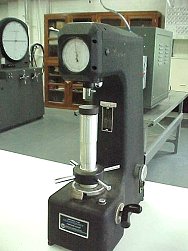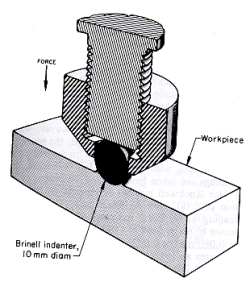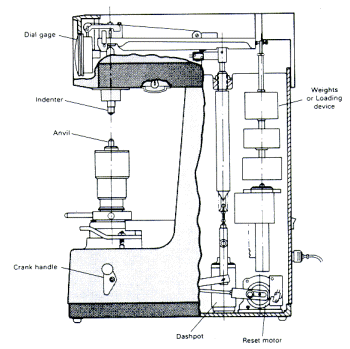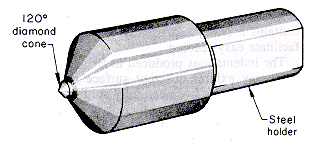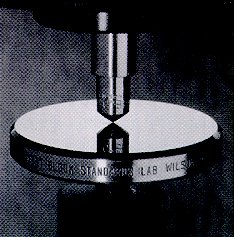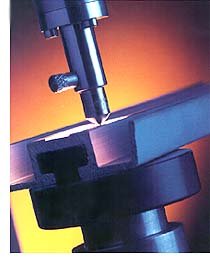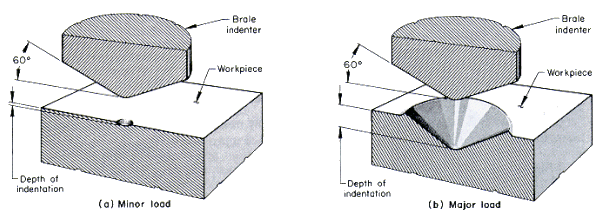ASTM E18-05 now requires the use of carbide ball
indenters, which produce results 0.5-1.0 Rockwell point below that of the
old steel indenters.
The Rockwell Hardness test is probably the most commonly
performed hardness test. It is easy to perform and the
hardness number is obtained directly from the testing
machine. The test consists of applying a minor load of 10 kg
to seat the indenter and then applying a major load
(typically 100 kg) to create a permanent depression beyond
that caused by the minor load. The hardness number, which is
read directly from a dial or digital scale on the testing
machine, is inversely related to the additional penetration
caused by application of the major load.
There are numerous variations of the Rockwell Hardness
test involving different penetrators and loads. A 120o
diamond cone
indenter with a slightly rounded point is used for testing very hard materials. Most
materials are tested using hardened steel ball indenters.
Steel indenters include 1/16, 1/8, 1/4, and 1/2 inch
diameters. Major loads can be 60, 100 or 150 kg. (superficial
hardness tests use lower load values).
The following contain images of Rockwell indentations taken with a light
microscope and a scanning electron microscope.
Rockwell hardness numbers should be reported by specifying
the type test and the scale on which the test was made. For
example 64 HRC means the hardness number is 64 as determined
on a Rockwell C scale. Most Rockwell hardness tests are
performed on either the Rockwell B or C scales. The B scale
utilizes a 1/16 inch diameter penetrator and a 100 kg major
load while the C scale uses a conical diamond penetrator and
a 150 kg major load.
Rockwell
hardness number, HR, is a number derived from the net increase in the
depth of impression from a fixed minor load to a major load
and then returned to the minor load. Rockwell hardness numbers are always quoted
with a scale symbol representing the penetrator, load, and
dial used.
| Scale Symbol |
Indenter |
Major Load, kgf |
Dial Figure |
Typical Applications |
| A |
Diamond |
60 |
Black |
Cemented carbides, thin steel, and
shallow case-hardened steel |
| B |
1/16" ball |
100 |
Red |
Copper alloys, soft steels, aluminum
alloys, malleable iron |
| C |
Diamond |
150 |
Black |
Steel, hard cast irons, pearlitic
malleable iron, titanium, deep case-hardened steel, and other
materials harder than HRB 100 |
| D |
Diamond |
100 |
Black |
Thin steel and medium case-hardened
steel and pearlitic malleable iron |
| E |
1/8" ball |
100 |
Red |
Cast iron, aluminum and magnesium
alloys, bearing metals |
| F |
1/16" ball |
60 |
Red |
Annealed copper alloys, thin soft
sheet metals |
| G |
1/16" ball |
150 |
Red |
Phosphor bronze, beryllium copper,
malleable irons. Upper limit is HRG 92, to avoid possible
flattening of ball. |
| H |
1/8" ball |
60 |
Red |
Aluminum, zinc, lead |
| K |
1/8" ball |
150 |
Red |
Bearing metals and other
very soft or thin materials. Use smallest ball and heaviest load
that do not give anvil effect. |
| L |
1/4" ball |
60 |
Red |
| M |
1/4" ball |
100 |
Red |
| P |
1/4" ball |
150 |
Red |
| R |
1/2" ball |
60 |
Red |
| S |
1/2" ball |
100 |
Red |
| V |
1/2" ball |
150 |
Red |
The governing standard for hardness testing of plastics is
ASTM D785. The procedure is as follows.
-
Set the dial gage within 10 seconds.
-
Apply the major load for 15 seconds. The
application time of the major load must be controlled carefully if
reproducible results are to be obtained.
-
Read the Rockwell hardness number 15 seconds after
removal of the major load.
Corrections can be made for specimens with curved surfaces based
on the radius of curvature.
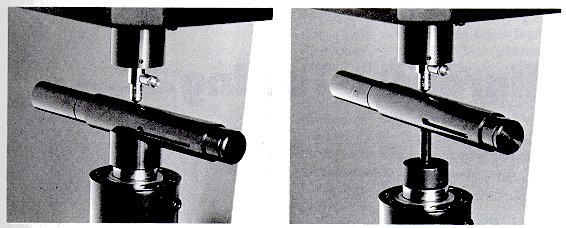
References
Metals Handbook, Ninth Edition, Vol. 8
"Mechanical Testing", American Society for Metals,
1985, Hardness Testing pp 71-113.
Handbook of Experimental Stress Analysis, by Hetenyi, John Wiley & Sons, Inc., 1950, pp 22-25.
Hardness Testing, 2nd Ed., ASM International, 1999, pp 29, 121.
